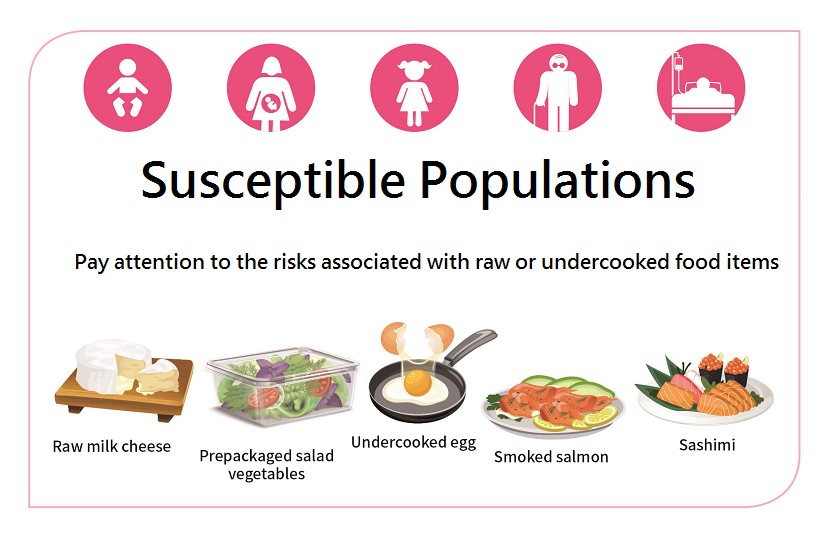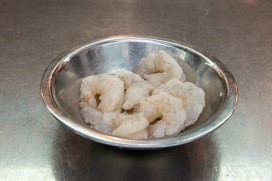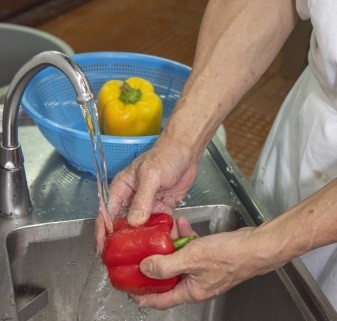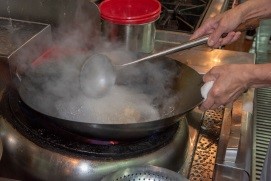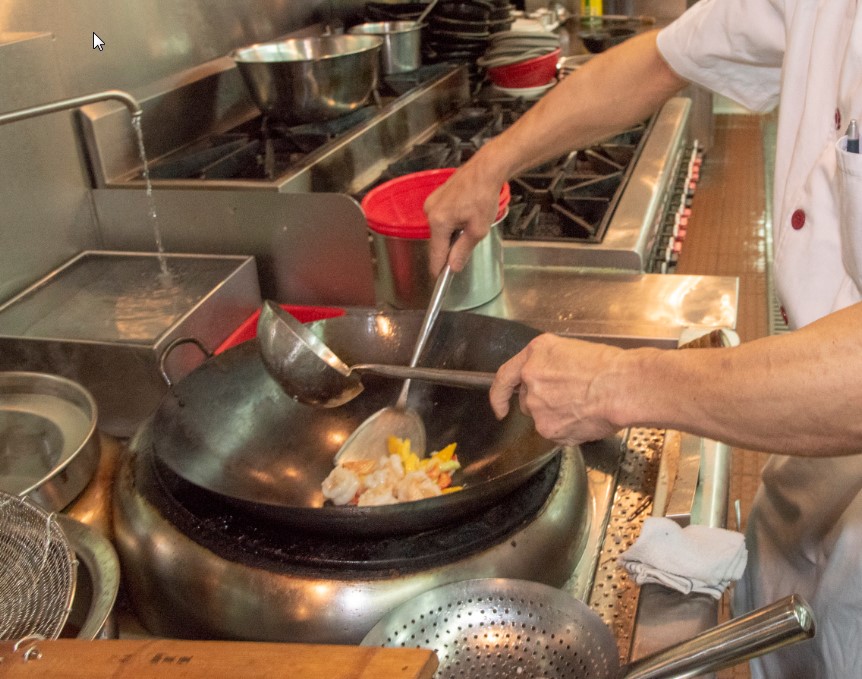
Feature Article
Risks of Eating Raw Foods
Some people choose to eat raw or undercooked foods for the original taste, but this comes with a higher risk of food poisoning. Consumption of contaminated raw foods is one of the most common causes of local food poisoning cases.
Food can be contaminated with pathogens, including “superbugs” (microorganisms resistant to antimicrobials), in different stages of food processing from farm to table. We should therefore pay attention to the farming/growing environments of foods commonly consumed raw. For example, oysters which are filter-feeders may ingest norovirus and Salmonella in contaminated water environments during feeding. Similarly in farms, vegetables grown in the field may be contaminated with Salmonella and E. coli if the irrigation water is polluted or the farmers handling them do not observe personal hygiene.
Moreover, the food processing environment may harbour microorganisms. For instance, smoked salmon may be contaminated with Listeria monocytogenes in its processing environment. Listeria monocytogenes cannot be eliminated by the cold smoking process and the long shelf life of smoked salmon allows the bacterium to grow. In fact, food handlers may also be a source of contamination if they do not observe good hygienic practices when handling foods, in particular raw foods involving manual handling, such as sushi and sashimi. To get rid of pathogens potentially present in raw foods, we should cook food thoroughly as heat can effectively kill pathogens.
Figure: Persons susceptible to pathogen infections are advised not to consume raw or undercooked foods.
Susceptible Populations
Food poisoning may happen to anyone, but susceptible populations including pregnant women, infants, young children, the elderly and people with weakened immunity (for examples, people with diabetes, liver or kidney diseases, organ transplants and HIV infection, or people receiving chemotherapy or radiation therapy) are, due to their health status, at a higher risk of being infected or having complications if they consume raw or undercooked foods. The symptoms of food poisoning range from mild to severe and vary depending on the type of pathogens. The most common symptoms include vomiting, diarrhoea, abdominal pain and fever, yet more severe or even life-threatening symptoms may occur in the susceptible populations. For example, Shiga toxin-producing E. coli (STEC) infection in very young children and the elderly is more likely to be associated with the haemolytic-uraemic syndrome (HUS). For Listeria infection in pregnant women, the symptoms may be relatively mild in the mothers, but the passage of the bacterium through the placenta may cause miscarriage, stillbirth or even infant death. In the case of the elderly and people with weakened immunity, Listeria infection may lead to severe bloodstream or brain infections.
Key Points to Note
- Raw or undercooked foods have inherent food safety risks as they can be contaminated with pathogens from farm to table.
- The consequences of food poisoning could sometimes be quite serious, particularly in the susceptible populations.
- Cooking food thoroughly before consumption is an effective way to eliminate foodborne pathogens and prevent food poisoning
Advice to the Trade
- Follow Good Manufacturing Practices and adopt food safety systems such as the Hazard Analysis and Critical Control Points to enhance food safety.
-
Food handlers should maintain good personal, environmental and food hygiene when handling food.
-
Labels (or placards at service locations) should be used to indicate the presence of raw or undercooked foods/ingredients in ready-to-eat items, stating, for instance, “Consuming raw or undercooked meats, poultry, seafood, shellfish or eggs may increase the risk of foodborne illnesses, especially if you have certain medical conditions”, so that consumers can make informed choices.
Readers' Corner
1) Antimicrobial Resistance — Also a Food Safety Issue
Antimicrobial resistance (AMR) has become a major global public health concern. In 2015, the 68th World Health Assembly launched a global action plan on AMR by applying a “One Health” approach to combat this emerging health threat. To tackle AMR locally, the Government launched the Hong Kong Strategy and Action Plan on Antimicrobial Resistance (2017-2022) in 2017 and called for multi-sectoral collaboration.
What Is AMR?
According to the World Health Organization (WHO), AMR is the ability of a microorganism (like bacteria, viruses and some parasites) to stop an antimicrobial agent (such as antibiotics, antivirals and antifungals) from working against it. As a result, standard treatments become ineffective, infections persist and may spread to others. Nevertheless, AMR is a natural phenomenon. Microorganisms become antimicrobial resistant spontaneously by gene mutation or gene transfer among each other.
How Does AMR Spread?
Many factors lead to the rise of AMR. One major contributing factor is the misuse and overuse of antimicrobial drugs, which accelerates the emergence of AMR in microorganisms. When antibiotics are given to sick people or food-producing animals, bacteria susceptible to antibiotics are killed and bacteria with resistant genes survive. Therefore, AMR bacteria may outgrow their counterparts and develop in our bodies or the guts of food-producing animals. These bacteria can spread among the public through the means shown below.
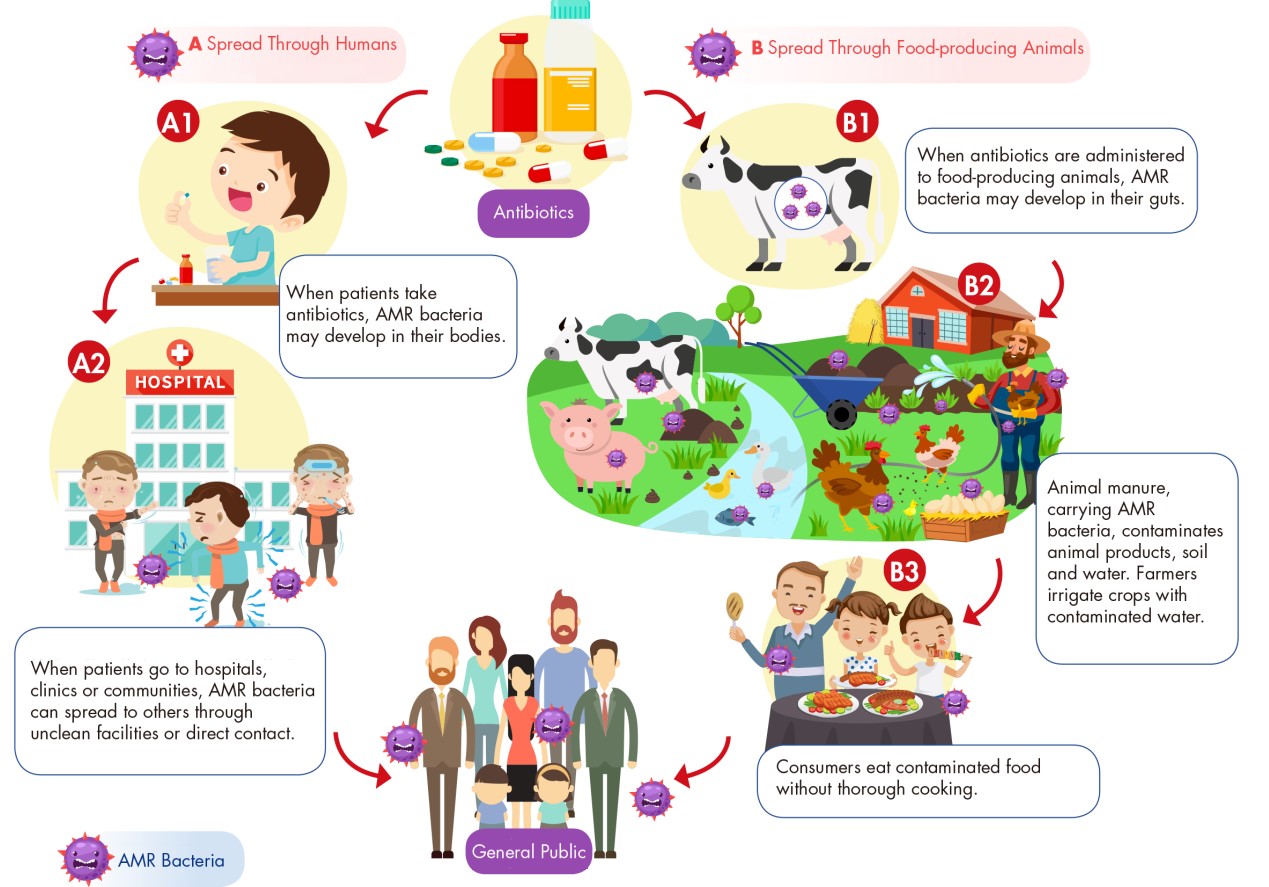
Diagram: Spreading of AMR bacteria through humans (Path A) and food-producing animals (Path B)
What Are the Measures to Contain AMR in the Food Chain?
To effectively minimise the emergence of AMR in the food chain and contain its spread, coordinated efforts across different sectors, including the veterinary profession and the agricultural, environmental and food industries, are required. Preventive measures are of the utmost importance. For examples, farmers should optimise the application of antimicrobials in livestock, antibiotics should not be used as growth promoters, and veterinarians should assist food animal production farms to adopt good husbandry practices to reduce the need for antimicrobials. As for food producers, they should take effective sanitation measures to maintain food hygiene and avoid cross contamination during food processing.
2) Tackling Superbugs in Foods
What Are Superbugs?
From time to time, there are media reports on finding of AMR bacteria in foods or food-producing animals. AMR bacteria are usually highlighted in media report as “superbugs”, which generally refer to microorganisms that have developed AMR. Different superbugs are reported usually because of their resistance to a wide range of antimicrobials or certain last-resort antimicrobials, which suggests emerging threats of treatment failure. Superbugs are usually named for their resistance genes or traits together with the names of the microorganisms. Extended-spectrum β-lactamase (ESBL)-producing Enterobacteriaceae is a superbug of concern. β-lactam is a large class of commonly used antibiotics. ESBLs are enzymes that can break down nearly all β-lactams and make them ineffective for treatment.
Superbugs are not necessarily pathogens. They can also be commensal bacteria that have acquired resistance genes. Commensal bacteria are organisms that derive benefits from their association with humans and are generally harmless. Superbugs that are commensal bacteria are also of concern, because commensal bacteria like E. coli and Enterococcus species serve as reservoirs of resistance genes that can be transferred to human pathogens transiting the intestinal tract. Commensal bacteria can also be human pathogens. For example, E. coli which is naturally present in the human intestinal tract is a common cause of urinary tract infection and blood stream infection.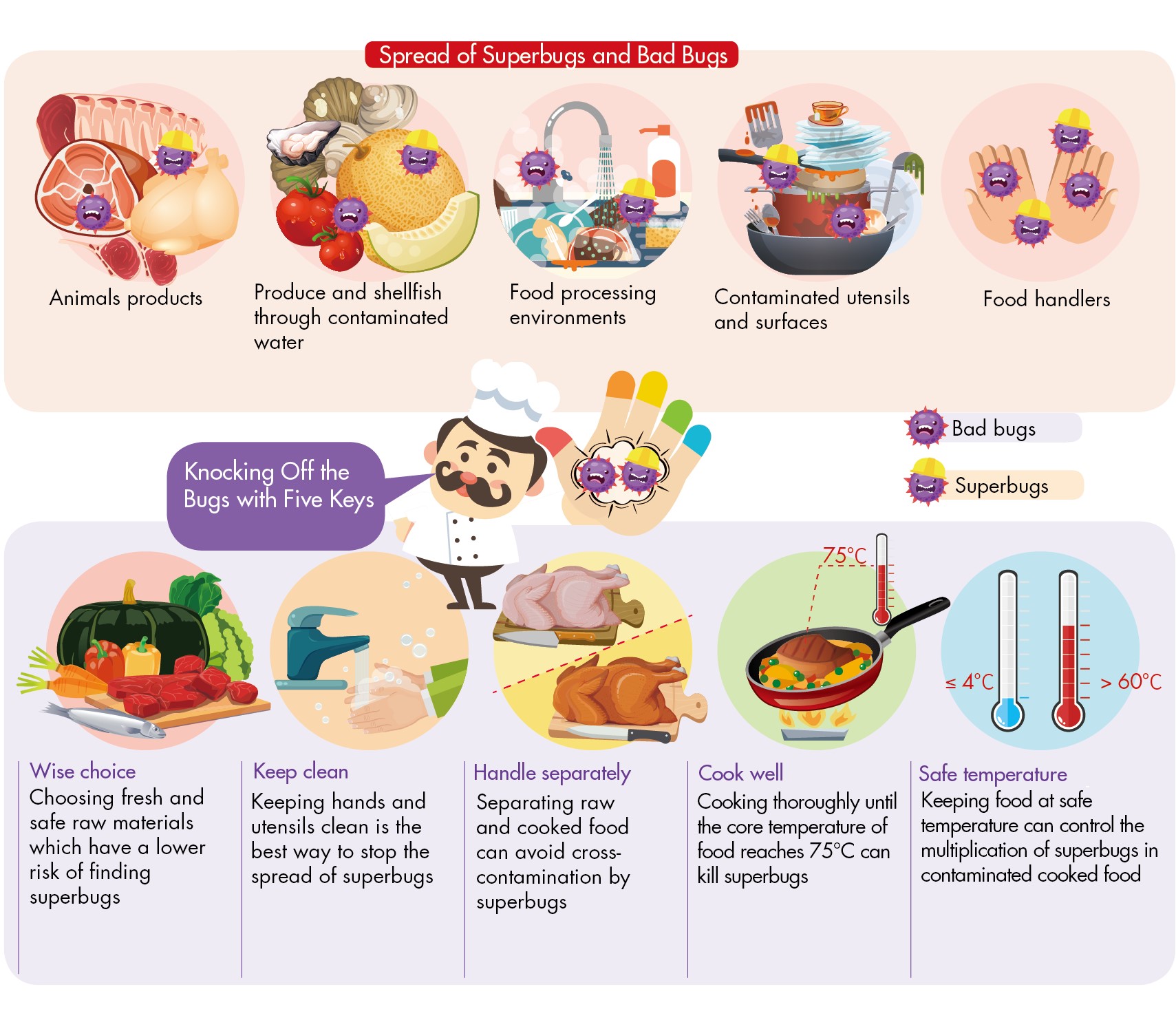
Figure: Combating superbugs and other bad bugs with Five Keys to Food Safety
Finding Superbugs in Food
While infection with superbugs in patients indicates an imminent threat, the finding of superbugs in food-producing animals or animal products (for example, poultry meat) indicates the spread of AMR. Locally, it was reported that more ESBL-producing E. coli were found in faecal samples from food-producing animals (cattle, pigs and chickens) than those from cats, dogs and wild rodents. However, as there are limited data, it is difficult to draw a comparison between the extent of superbugs transmitted via food-producing animals to humans and that via humans to humans. That said, the increase in the occurrence of superbugs in food-producing animals is likely to pose a risk to human health. Hence, it is important to monitor superbugs in samples of food and food-producing animals, and also in human specimens. The Codex Alimentarius Commission re-established the Intergovernmental Task Force to set guidelines on integrated AMR surveillance. An integrated surveillance on AMR in both humans and animals/animal products can help identify the spread of superbugs and their potential threats.
Knocking Off Superbugs with Five Keys to Food Safety
To combat superbugs and other bad bugs, it is important to practise the Five Keys to Food Safety when handling food in daily life. Susceptible populations and those who wish to further reduce the risk of foodborne illnesses should avoid consuming raw and undercooked foods which are more likely to carry microorganisms (including superbugs) than thoroughly cooked foods.
News on New Dishes
Stir-fried Prawns with Bell Peppers and Mangoes
Colour, aroma and taste are the three essential elements of Cantonese cuisine. Seasonal fruits are sometimes added to enhance the colour and taste of dishes. In this issue, we bring you the “Stir-fried Prawns with Bell Peppers and Mangoes”. The refreshing taste of mango will whet your appetite. Mr NG Wai-kwong, Head Chef of Full House Seafood Chinese Restaurant (a signatory of the Food Safety Charter) will show us how this dish is prepared.
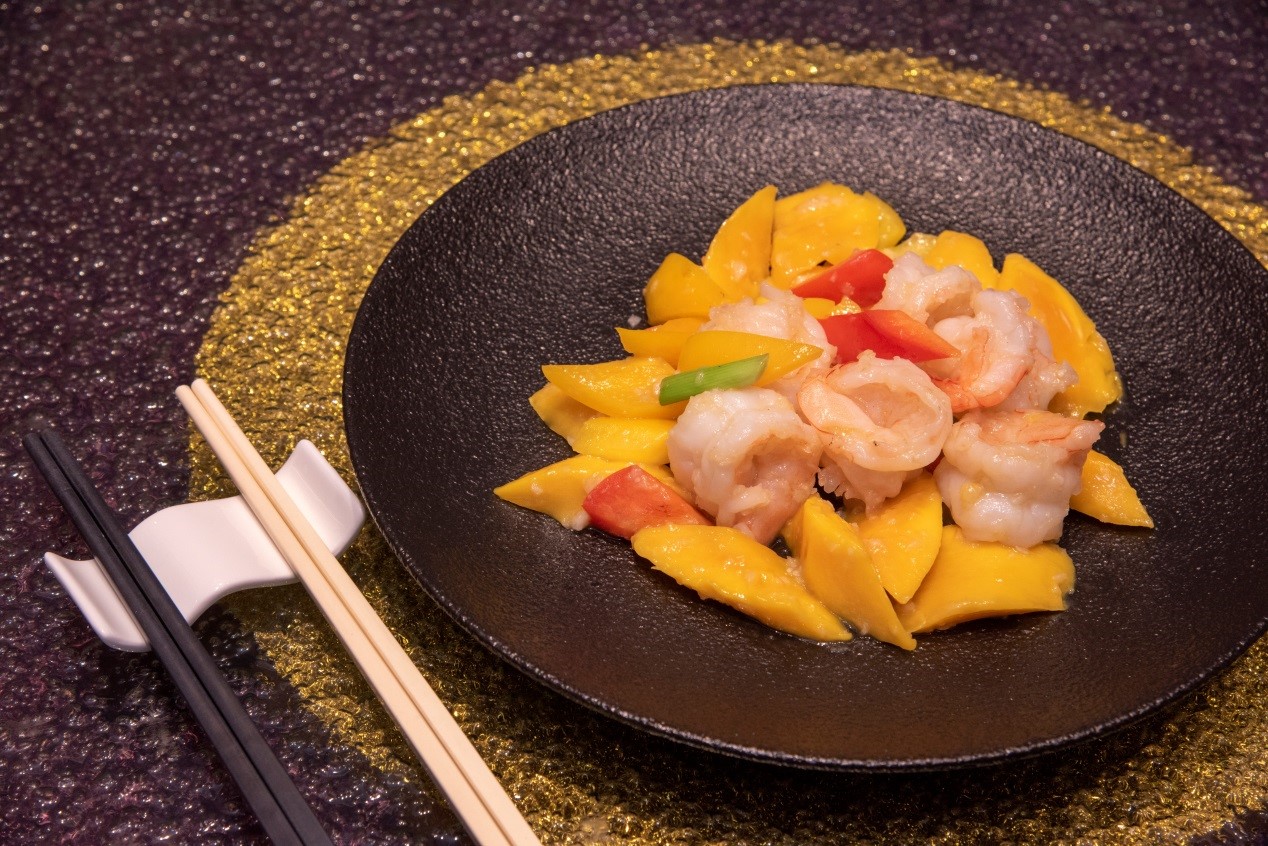
| Preparation Steps | Small Tips, Big Wisdom | |
|---|---|---|
|
Receiving
|
Purchase ingredients such as red and yellow bell peppers, frozen prawns and mangoes from approved and reliable suppliers. | Upon receipt of the ingredients, check carefully to ensure that they are fresh and not damaged. Vegetables and fruits (e.g. bell peppers and mangoes) should be kept in a chiller set at 4°C or below and frozen prawns in a freezer at -18°C or below. |
|
Defrosting
|
Thaw the frozen prawns under running water. Rinse the prawns and marinate them with egg white, corn flour and a pinch of salt. |
Handle and cook thawed frozen food as soon as possible to avoid bacterial growth. |
|
Rinsing and Cutting
|
Rinse the red and yellow bell peppers, mangoes, garlic and spring onions thoroughly. Slice the red and yellow bell peppers. Peel and pit the mangoes, cut them into strips. Peel and mince the garlic. Cut the spring onions into sections. |
Rinsing the vegetables and fruits thoroughly under running water can effectively reduce the risk of pesticide intake |
|
Blanching and Quick Deep-frying
|
Blanch the marinated prawns in boiling water for 15 seconds, take out and drain. After that, deep-fry the prawns in boiling oil for 10 seconds and take out. |
Blanching the prawns until they are half done can shorten the cooking time and reduce the amount of oil used. Quick deep-frying gives the prawns a firm and crunchy texture. |
|
Stir-frying
|
Stir-fry the bell peppers, garlic and spring onions on high heat for about 30 seconds. Toss in the prawns and stir-fry for another 30 seconds. Add some broth and put in the mangoes. Stir-fry for about 30 seconds. |
The use of natural ingredients (e.g. garlic and fruits) helps reduce seasonings. |
|
Serving
|
Dish up and serve. |
If the food is not consumed immediately, it should be cooled as quickly as possible and refrigerated within two hours. Cooked food left at room temperature for more than four hours can allow bacteria to grow and should not be consumed. |
Having been in the culinary industry for more than 30 years, Chef NG Wai-kwong specialises in cooking seafood and making Cantonese dim sum and siu mei. He shared with us the following tips on the dish Stir-fried Prawns with Bell Peppers and Mangoes:
Food Safety Plan Corner
Stir-fried Prawns with Bell Pepper and Mangoes
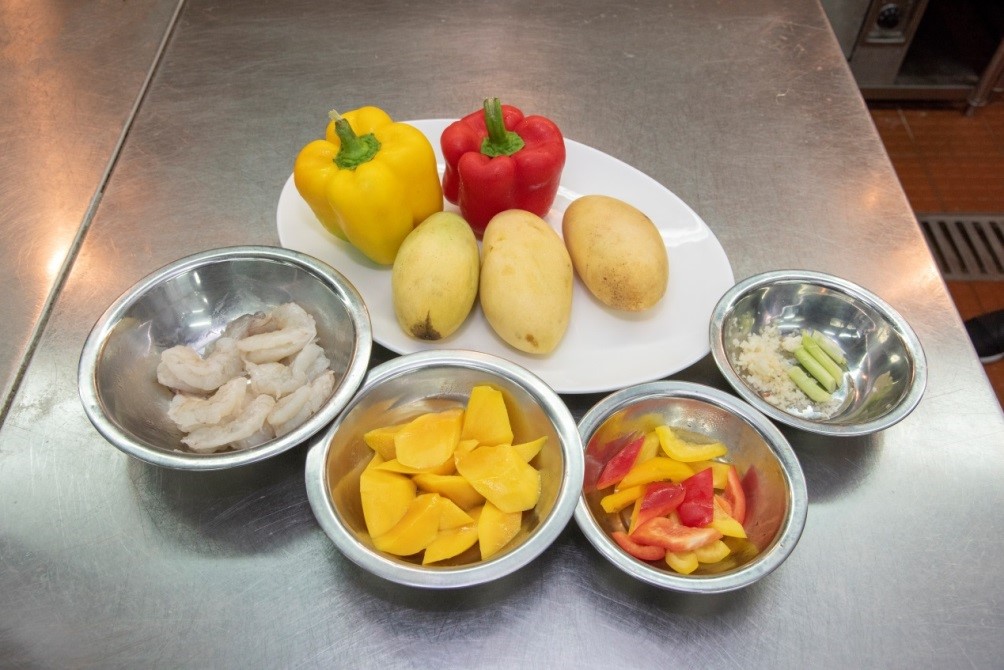
Ingredients :
Frozen prawns, red and yellow bell peppers, mangoes, garlic, spring onions, broth.
Steps:
- Take out the frozen prawns kept in a freezer set at -18°C or below. Thaw them under running water.
- Rinse the prawns and marinate them with egg white, corn flour and a pinch of salt.
- Take out the red and yellow bell peppers, mangoes, garlic and spring onions kept in a chiller set at 4°C or below. Rinse them thoroughly.
- Slice the red and yellow bell peppers. Peel and pit the mangoes and cut them into strips. Peel and mince the garlic. Cut the spring onions into sections.
- Blanch the marinated prawns in boiling water for 15 seconds, take out and drain. Deep-fry the prawns in boiling oil for 10 seconds and take out.
- Heat the wok and add in some oil. Stir-fry the bell peppers, garlic and spring onions on high heat for about 30 seconds.
- Toss in the prawns and stir-fry for another 30 seconds. Add some broth and put in the mangoes. Stir-fry for about 30 seconds. Dish up and serve.
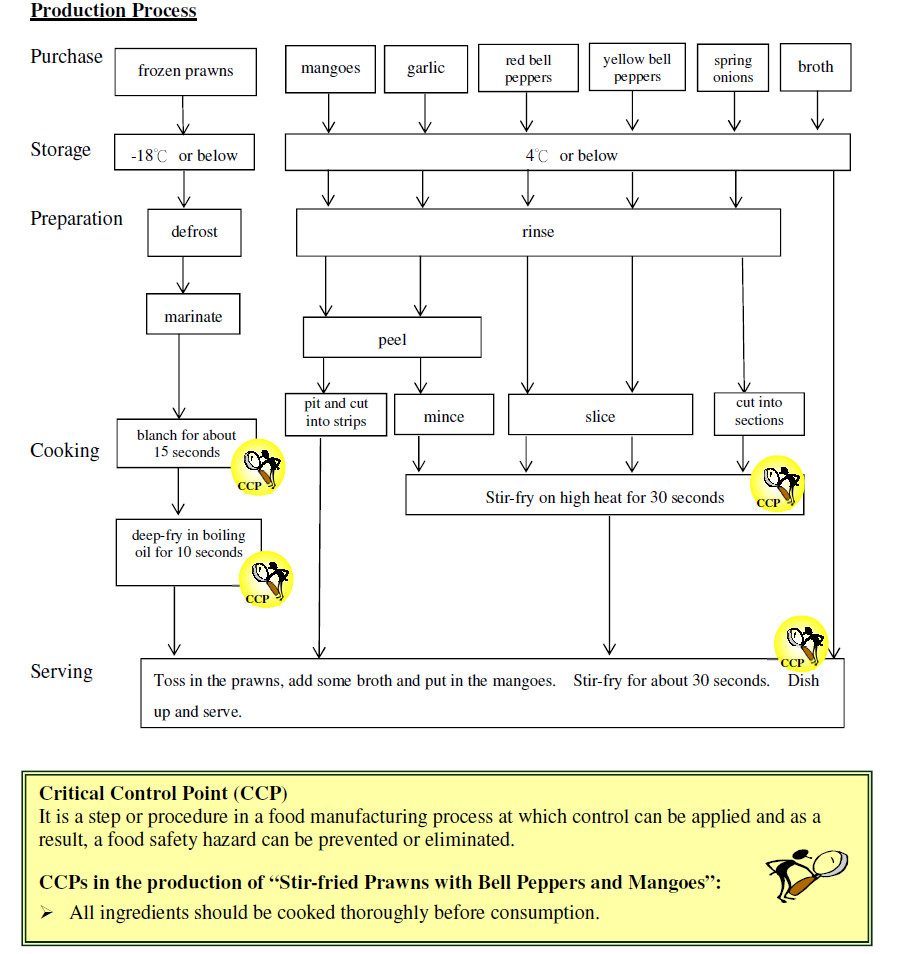
Activities
Roving Exhibitions on Food Safety
The Centre for Food Safety (CFS) mounts a number of thematic exhibitions in shopping centres of public and private housing estates across the territory every year. Exhibition boards covering topics such as food safety and nutrition are displayed, and education videos are shown to enhance public knowledge on how to make safe and suitable food choices. The latest arrangements for the exhibitions will be announced regularly. For more details, members of the public are welcome to log on to the CFS website through the following link:
https://www.cfs.gov.hk/english/whatsnew/whatsnew_act/whatsnew_act_roving_exhibition_2018.html
For enquiries, please contact the Communication Resource Unit of the CFS on 2381 6096.
Upcoming Activities
Trade Talk and Workshop on Hazard Analysis and Critical Control Point (HACCP)

The CFS will organise the Trade Talk and Workshop on HACCP 2019 from March to December 2019 to promote proper food processing procedures among food handlers. Apart from soliciting the trade's active participation and support in implementing government's initiatives, the CFS will promote the adoption of the HACCP System and the application of the Food Safety Plan in food processing with a view to enhancing food safety.
These seminars will enable the trade to have a better understanding of the principles and operation of the HACCP System and the “5 Keys for Food Safety” advocated by the WHO, namely 1. Choose (choose safe raw materials); 2. Clean (keep hands and utensils clean); 3. Separate (separate raw and cooked food); 4. Cook (cook thoroughly); 5. Safe temperature (keep food at safe temperature), in order to prevent foodborne diseases effectively. Besides, topics such as the dietary culture of less-salt-and-sugar diet, nutrition labelling and the health implications of trans fat will also be covered.
Food premises will receive invitation letters and enrolment forms listing the dates, time and venues of the Trade Talk and Workshop on HACCP. Information on the activities will be available at the CFS website (https://www.cfs.gov.hk). Members of the trade are welcome to visit the website for details.
Food Safety Q&A
Is the mudskipper a toxic fish?
The mudskipper (for example, the Boleophthalmus pectinirostris) is a very common non-toxic fish species which is edible. However, looks similar to the toxin-containing Yongeichthys criniger and accidental consumption of the latter will cause poisoning. In March 2007, there was a poisoning incident in Zhanjiang City, Guangdong Province in which one villager died after eating the Yongeichthys criniger.

The Yongeichthys criniger contains tetrodotoxin which is a potent marine neurotoxin. While the lethal dose of tetrodotoxin for humans is around 2mg, the minimum dose necessary to cause poisoning symptoms has been estimated to be 0.2mg. The symptoms normally develop within 10 to 45 minutes after ingestion, but may be delayed by 3 hours or more. Victims may experience paraesthesia in the face and extremities, which may be followed by dizziness or numbness, nausea, vomiting, rapid breathing and irregular heart rate. In extreme cases, the toxin can cause death. All humans are susceptible to tetrodotoxin poisoning. Since there are currently no antidotes or antitoxins to the toxin, treatment of symptoms is hence supportive.
Some people catch mudskippers on mudflats for consumption. Members of the public should beware of the risk of consuming the Yongeichthys criniger which is taken to be the mudskipper.
Advice to the Trade and Consumer
In Hong Kong, any food available for sale on the market must be fit for human consumption. The trade should exercise particular care when importing and selling fish and fish products and ensure they are safe for consumption. Consumers are advised to avoid consuming unknown fish.
Truth against Fallacy
Is it healthier to eat more oats?
Oats are a cheap and nutritious cereal crop, frequent consumption of which is effective in reducing the amount of total cholesterol in blood. That’s why many people take oats in breakfast. In recent years, however, there have been press reports on the pesticide glyphosate found in oatmeal. The fact that the International Agency for Research on Cancer has classified glyphosate as a substance “probably carcinogenic to humans” has aroused public concern over the safety of oatmeal products.
The Joint FAO/WHO Meeting on Pesticide Residues, the European Food Safety Authority and other relevant overseas authorities could not establish linkage between glyphosate and cancer in humans at this stage. To safeguard food safety, the Maximum Residue Limits (MRLs) of glyphosate have been set as one of the measures to regulate levels of glyphosate and other herbicides in foods worldwide, including Hong Kong.

Under the Pesticide Residues in Food Regulation (Cap. 132CM), the MRL of glyphosate in oats is 30 mg/kg, which is the same limit adopted by the Codex
The CFS has been collecting oatmeal samples under the food surveillance programme for testing glyphosate. All test results were satisfactory. There is no health concern over usual consumption of oatmeal products by the general public.
Brain Gym
Fill in the blanks
-
In which part of the refrigerator should we store different types of food?
Options: a) Uncooked foodb) Ready-to-eat or cooked food
Upper
Compartment: _____
Lower
Compartment: _____
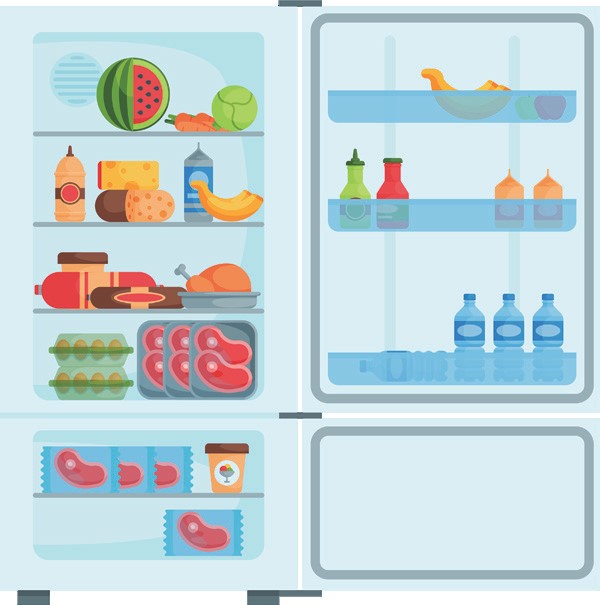
Store food properly to avoid cross contamination. -
When we wash our hands with warm water and liquid soap, how long should we rub our hands?
Options : a) 5 seconds b) 10 seconds c) 20 seconds

Keep clean at all times, and develop good habits.
Rub for :_______________
-
Please indicate the dangerous temperature and safe temperature.
Options: a) Dangerous temperature b) Safe temperature
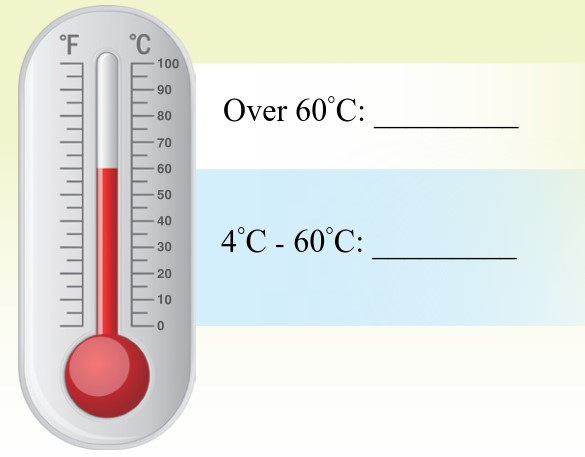
Microorganisms multiply speedily at dangerous temperatures.
We should ensure that food is kept at safe temperatures.
Answers
1) Upper compartment: b) Ready-to-eat or cooked food/
Lower compartment: a) Uncooked food
2) c) 20 seconds
3) Over 60°C: b) Safe temperature /
4°C-60°C: a) Dangerous temperature
Enquiries and Subscription
Printed copies of the Food Safety Express can be obtained from the Communication Resource Unit at 8/F, Fa Yuen Street Municipal Services Building, 123A Fa Yuen Street, Mong Kok, Kowloon. For enquiries, please call 2381 6096.
